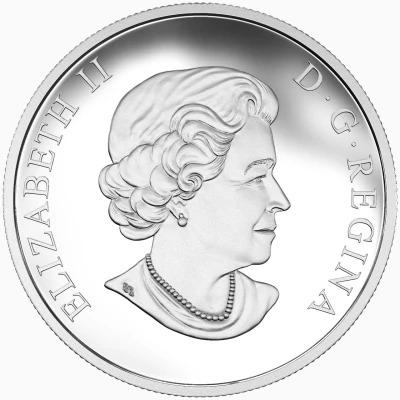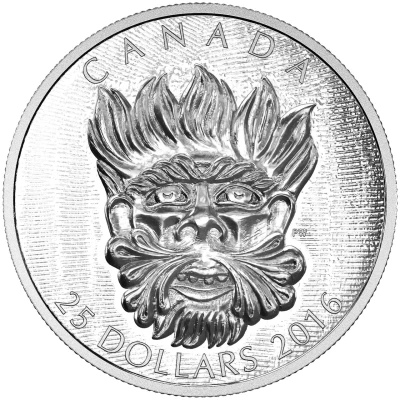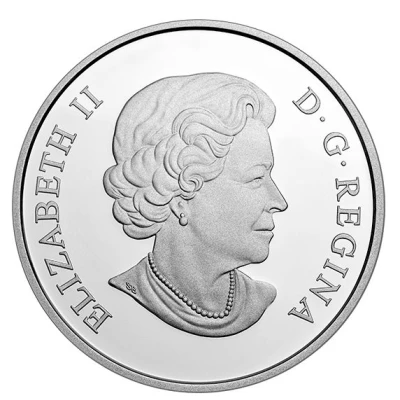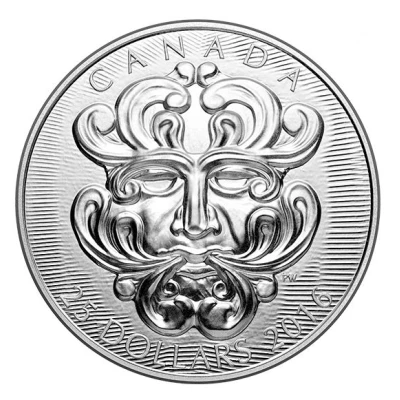


25 Dollars - Elizabeth II Grotesque Wild Green Man
2016 year| Silver (.9999) | 30.75 g | 36 mm |
| Issuer | Canada |
|---|---|
| Queen | Elizabeth II (1952-2022) |
| Type | Non-circulating coin |
| Year | 2016 |
| Value | 25 Dollars 25 CAD = USD 18 |
| Currency | Dollar (1858-date) |
| Composition | Silver (.9999) |
| Weight | 30.75 g |
| Diameter | 36 mm |
| Shape | Round |
| Technique | Milled (high relief) |
| Orientation | Medal alignment ↑↑ |
| Updated | 2024-10-04 |
| Numista | N#377985 |
|---|---|
| Rarity index | 97% |
Reverse
Engraved in ultra-high relief, your coin was inspired by pieces from the East Block of Parliament, reinterpreted by Dominion Sculptor Phillip White. This fierce and wild-eyed figure has ancient links to pre-Christian mythology and is believed to symbolizegrowth and rebirth, the cycles of life. He is often depicted with dense foliage, and here, his hair, brows, moustache and beard are made of leaves—a wildly mysterious grotesque exquisitely crafted in ultra-high relief.
Script: Latin
Lettering:
CANADA
25 DOLLARS 2016
Designer: Phil White
Edge
Plain
Script: Latin
Lettering: 1 OZ FINE SILVER 1 OZ ARGENT PUR
Comment
Located in the heart of the nation's capital on a promontory overlooking the majestic Ottawa River and the Gatineau Hills in the distance, Canada's Parliament Buildings represent the heart of our democracy. Their majestic walls house an extraordinary collection of thousands of Canadian sculptures. The Royal Canadian Mint is proud to present one of the many magnificent works that adorn these buildings with the first issue of its exceptional series of 99.99% pure silver coins featuring sculptures inspired by the sculptural art of Parliament.Did you know?
The buildings on Parliament Hill are among the world's most important examples of the Gothic Revival architectural style. Whether in the Centre Block, East Block or West Block, each building incorporates elements of this style, but in a uniquely Canadian way - that is, by including Canadian themes and materials in the flying buttresses, pointed arches and stone masonry that are characteristic of Gothic architecture, which emerged in Europe during the Middle Ages. Canadians may be surprised to learn that thousands of sculptures adorn the Parliament Buildings, both inside and out (there are around three thousand outside alone). These works include sculptures of mythical animals and species of Canadian flora and fauna, ornamental and decorative carvings on doors, spandrels and partitions of stone and wood, figures, finials and wrought-iron railings, coats of arms and badges, high and low reliefs depicting historical figures and events (including a 16-panel frieze recounting 25,000 years of Canadian landmass and national history), busts, statues and portraits, richly ornamented vaulted ceilings, strikingly beautiful stained-glass windows and countless carved maple leaves.
The Parliament Buildings also feature hundreds of marmosets, which are fantastical ornamental figures carved in stone or wood. In the Gothic and Neo-Gothic architectural styles, monsters and mythical creatures are the favorite subjects of this type of ornamental carving. The motif of this piece is inspired by a marmoset adorning the East Block of Parliament Hill, depicting the figure of a wild green man. Usually composed of a human face formed from dense foliage or appearing in such vegetation, the green man motif symbolizes the cycle of seasons and years, as well as evoking, more broadly, ideas of growth, rebirth and resurrection. It is closely associated with the motif of the wild man, a fierce, shaggy and mysterious figure also inspired by pre-Christian European mythology. In the context of the Neo-Gothic style, these two figures are usually depicted with threatening or humorous features.
Hidden among the hundreds of sculptures embellishing the interior of the Parliament Buildings are horns and dragons, whimsical portraits such as those of Thomas Fuller, original architect of the first Centre Block, and John A. Pearson, architect responsible for rebuilding the Centre Block after its destruction by fire on
February 3, 1916, wigged and shielded senatorial owls, roaring gargoyles and chimeras, dinosaurs, coiled telecommunication cables, figures from First Nations mythology, a senator playing golf, a member of Parliament with three languages giving a speech, a face with a finger in front of its lips warning MPs to keep their secrets, and more.
For most of Parliament's history, the sculpture workshop was located in the basement of the Senate Chamber (Centre Block). Masons and sculptors could only work there at night and during the summer recess, which meant irregular working conditions with frequent interruptions. The workshop was subsequently moved outside the Parliament building to allow workers to carry out their activities during normal working hours and benefit from daylight.
Production of the Centre Block sculptures began in 1916 and continues to this day. According to the building's original design, some 170 blocks of stone remain to be carved. The Parliament Buildings are the only federal government buildings in North America to be the site of such full-time carving, which is more than just a permanent restoration activity.
Canada has had five official sculptors (known as the Federal Government Sculptor or Dominion Sculptor) whose role has been to complete the interior and exterior ornamentation, conservation and restoration of the Parliament Buildings: Cléophas Soucy (1936-1949), William Oosterhoff (1950-1962), Eleanor Milne (1962-1993), Maurice Joanisse (1993-2006) and Phillip White (2006-present).
In the 1990s, Dominion sculptor Maurice Joanisse undertook the considerable task of cataloguing each of the works located outside the East, West and Centre Blocks. He photographed them and recorded their size, condition and history. Some were in such poor condition that he had to interrupt his cataloguing work to repair them without delay. He compiled a database of information on over3,000 works outside the buildings alone.
Packaging
The coin is encapsulated and presented in a burgundy double-shell case adorned with the Royal Canadian Mint logo. The case comes with an illustrated protective box.
Interesting fact
The Grotesque Wild Green Man coin features a unique design that blends traditional engraving techniques with modern digital design elements, creating a striking and intricate image that appears to leap off the coin's surface.
Price
| Date | Mintage | VG | F | VF | XF | AU | UNC |
|---|---|---|---|---|---|---|---|
| 2016 | 2038 | - | - | - | - | - | - |
Values in the table are based on evaluations by sales realized on Internet platforms. They serve as an indication only for 25 Dollars - Elizabeth II (Grotesque Wild Green Man) 2016 coin.



